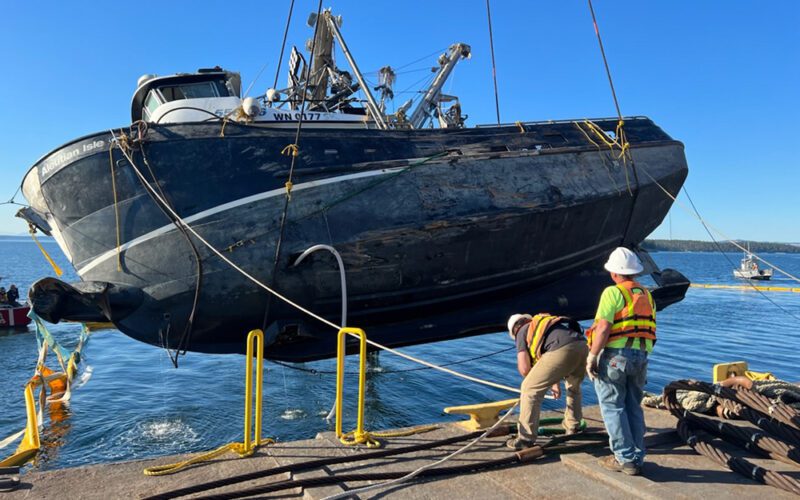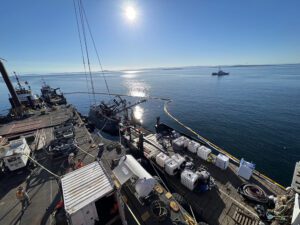
It is easy to see a company’s successes above water, but there’s also some quality work happening beneath the surface.
Whether it is pulling wreckage from seemingly unreachable depths or laying down hundreds of miles of cable that would provide internet access to remote Alaskan communities, these companies and their talented workforce of experienced divers, salvage experts and support staff are the industry’s underground workhorses.
Here is a look at what these diving and salvage companies are accomplishing along the West Coast:
AMERICAN MARINE CORP.
2022 has been a busy year for longtime West Coast specialty marine contracting, commercial diving and vessel support services company American Marine Corp.
“Our wide range of operations have kept us extremely busy,” said AMC Executive Vice President David Shahnazarian. “This year has been another great year of building relationships with new clients and continuing to provide solutions for our long-standing client base.”
Shahnazarian said the company has had an exceptional portfolio of projects among the firm’s three offices in Anchorage, Los Angeles and Honolulu, including multiple Trans-Pacific subsea cable installations, replacement and repair of subsea oil and gas pipelines and infrastructure, and diving inspections and repairs of critical infrastructure in the Alaska, Los Angeles and Honolulu seaports.
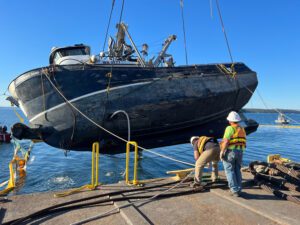
In a Port of Alaska modernization project, for example, American Marine was hired by Pacific Pile and Marine to put in the subsea cathodic protection system for the port’s new infrastructure. This work called for the company to use its specialty Cook Inlet Diving Service Vessel Shamrock.
AMC installed a dozen 15,000-pound anode sleds, multiple collar anodes on various pilings and multiple fender anodes to protect the dock fender system from corrosion, according to the company.
The work was done in 30-foot tidal changes with zero visibility and currents up to 7 knots.
“This was a critical project for the state of Alaska to protect the investment in upgrading the port infrastructure and capabilities,” Shahnazarian said.
American Marine was also hired for a subsea fiber optic cable installation project that involved providing ROV (remotely operated vehicle) monitoring and help in installing a subsea fiber optic cable from Asia to California. The project required cable monitoring up to 2,000 nautical miles water depth.
“AMC utilized our advantageous waterfront facility located in the Port of Los Angeles to perform a large mobilization of the offshore vessel for operations,” Shahnazarian said. “We had to perform various retrofits to accommodate the equipment on board the vessel and our ABS certified welding team was critical in making this happen in short order.”
AMC also performed an emergency response and salvage of a sinking vessel that drifted and became a hazard to navigation in the Port of Honolulu. The 35-foot sailboat was not only leaking oil and fuel, but it was also blocking the sole entry point into Honolulu Harbor for freight movers, fishing and cruise vessels.
The Hawaii Department of Transportation’s Harbors Division reached out to AMC, which removed the sailboat within eight hours, American Marine Vice President Michael MacDonald said.
The work required highly experienced divers who performed the job at night with no visibility, he remarked.
“Looking forward, we are optimistic in the growth opportunities on the West Coast and utilizing our over 40 years of experience to be an integral member of that growth,” Shahnazarian said. “We anticipate a large volume of work between the various private- and government-funded projects coming out.”
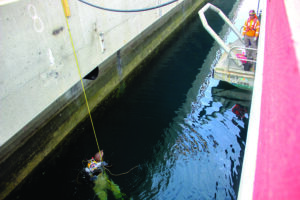
GLOBAL DIVING AND SALVAGE
Global Diving and Salvage, the longtime Seattle-based company with locations in Alaska and California, now leads the Dive/Marine Construction business line of Moran Towing Corp. Moran is a 160-year-old New Canaan, Connecticut-based marine transportation firm with 17 locations along the East Coast and the Gulf of Mexico and one of the largest privately held maritime companies in the U.S.
“Together Global, Moran and sister company Moran Environmental Recovery … provide safe and effective solutions to government, marine and energy industries throughout North America and beyond,” said Global Diving and Salvage and Moran Dive/Construction Business Unit Senior Vice President Dan Pierson. “The scope and scale of integrated services that we provide are unmatched and we are still realizing the power of bringing together this group of companies in ways that greatly benefit our clients.”
Meanwhile, Global has been flexing its know-how along the West Coast. In California, Global recently completed work on a project to build the Port of Long Beach’s new Fire Boat Station 20. Global was the subcontractor to Manson Construction Co., which was responsible for driving the pile, constructing the new fire boat bay deck and making repairs to the existing sea walls that make up Berths 50 and 51.
The project involved a sunken barge recovery. An old barge that sank many years ago in the corner of Berths 50 and 51 needed to be recovered to clear the sea floor for the new boat bay. The work also encompassed large void repair. The sea wall under Berth 50 is made up of 20-foot-long by 20-foot-tall concrete panels. A large void existed behind the panel at the corner of Berth 50 and 51, according to Global Diving and Salvage Operations Manager Jim Greene.
“Global fabricated bracing on site that was bolted in place to secure this panel to the panels adjacent,” Greene said. “The gap between the sea floor under this panel was reinforced with Fabriform grout bags that were secured to the sea floor with rebar stakes. The Fabriform grout bags were then inflated with concrete to provide a seal under the panel.”
Holes were then core drilled through the surface behind the panel into the void to allow concrete tremie tubes to be installed so that concrete could be pumped into the void, he added.
Global also worked on a number of other projects in 2022. In Washington, Global was hired by the U.S. Coast Guard in August to support the Aleutian Isle recovery effort in San Juan Island.
The vessel sank in the 150-foot area and slid down a slope to 250 feet, resting precariously at the edge of the abyss in an area of strong ocean currents, said Kerry B. Walsh, marine casualty project manager and salvage master. Walsh served along with Global’s salvage masters Kris Lindberg and Katy Stewart.
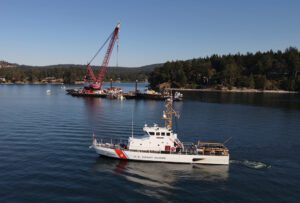
“We rely heavily on ROV support to review and monitor the scene below the surface,” the team said. “We have six experienced divers in the dive-operations rotation. Our crews began removing hazardous fishing nets from the vessel to provide safer access to the wreck, followed by securing valves, vents and hydraulics to reduce the amount of fuel and harmful environmental contaminants from being released.”
The vessel was raised to the surface, moved to a shallow, more protected location and was cleared of bulk hydrocarbons to the best extent possible, before being hoisted to the deck of the barge, the team said.
In Alaska, Global’s Anchorage office is contracted to work on the GCI AU-Aleutians Fiber Project, supporting roughly 800 miles of fiber cable installation from Kodiak along the south side of the Alaska Peninsula and the Aleutians to Unalaska.
“The completion of this project will provide some of the most remote communities in the nation with urban-level connectivity within the next two years,” Global’s Alaska business manager Kendra Bulawa, said.
Global’s diving and shore-end service crew worked for three months to support the onshore installation, protection and burials of cable landings at seven locations, including Unalaska, Akutan, Kodiak, King Cove, Sand Point and Chignik, Bulawa said.
“Use of a single, multi-skilled support team allowed Global to successfully complete each location ahead of schedule, while minimizing both costs and required local support,” she explained. “Inclement weather, tidal schedules and shore-end conditions were constantly monitored, and operations were modified as necessary to ensure the project stayed ahead of schedule.”
Global said that it expects business to grow; projects that had been paused or delayed due to COVID are picking back up and the company is bidding out through the end of 2023 with a good backlog of work coming up, Pierson said.
Global said that it plans integration of more technology in the coming years, including ROV, which is becoming more advanced, while other technologies are being created to perform some of the work that has historically been done by divers, Pierson said.
“While this shifts the way we perform our work, we intend to stay on top of cutting-edge technologies to provide clients with services unlike what has been offered in the past,” he said, adding that robotic cleaning services are one example.
“We are now looking at training our divers to utilize automated technology robotic cleaning tools, giving us the ability to provide trash-rack cleaning, pump-bay cleaning and culvert cleaning, for example, with limited or no diver entry,” he added.
Dive teams are trained to operate the fully submersible robotic technology and are on-site if diving services are needed, Pierson said.
“This type of new service gives us the ability to work in inaccessible traditional dredging/cleaning areas,” he explained. “The future of the industry will be focused on providing alternative project plans to clients that utilize the specialized skills of dive companies coupled with options to offer marine technology services to bring access and maneuverability to conditions that personnel cannot, and the capacity to perform large projects limiting the higher- risk exposure to our staff. The industry will be able to harness the power of new technologies to deliver safer, more efficient services to clients.”
ASSOCIATED UNDERWATER SERVICES
A Washington state-based commercial diving business with locations in Spokane, Seattle and Northern California, Associated Underwater Services has been lending its expertise in underwater and marine construction, salvage, ship husbandry and sonar services throughout the region and beyond.
“At AUS, we are dedicated to continuously expanding our knowledge through participating in state-of-the-art, unprecedented projects,” the company said in a statement. “We continuously strive to make projects safer, faster and more environmentally friendly in subsea intervention.”
Associated has been tapped for various projects, including the recent salvage of a two-story houseboat and a power boat that caught fire and sank on Lake Washington. The work required divers to attach lift bags to raise the sunken vessels.
At Dalles Marina, Associated Underwater Services responded to a fire that was ravaging houseboats and docks at the marina. The company activated an emergency response team to reduce the environmental impact from the blaze, deploying booms to limit hazardous material from spreading to the Columbia River.
The company also watched the docks for spot fires, as well as salvaged and removed burned docks.
For another project, American Cruise Lines hired the company to detach a mooring line tangled up in the propeller of American Pride so the 295-foot cruise ship could continue its journey to Clarkston, Wash.
AUS also assisted the state Department of Ecology’s Office of Columbia River and Chelan County’s water conservation efforts by offering its diving services on the Icicle River near Leavenworth, Wash. The company worked on the Supersack installation, as well as pump installation and underwater concrete cutting and cofferdam removal.
Over the summer, the company was hired to recover three pressure-relief panels that fell off the Hungry Horse Dams withdrawal system in Montana. AUS relied on its divers and remote operated vehicle system to get the job done, which involved handling 150-pound, 50-foot by 25-foot panels that “had been wedged in place at 240-feet depth (270-feet theoretical),” AUS said.
Divers also worked on the Sammamish Bridge Project, which involved dredging, cutting timber support piles and rigging the bridge footings to be removed on four different bridge piers, according to the company.
“The purpose of footings is to support the foundation (and) prevent settling and is crucial to providing the proper support for the structure,” Associated explained in a statement. “AUS divers dug under the 58-ton concrete footings in order to expose the wood timbers before using an underwater chainsaw to cut the footing free. It was then lifted to the surface.”
The company also was busy on a number of projects in fall 2021, including one that required its divers to descend to a depth of 150 feet to inspect, fix and replace an underwater aerator system on Kent Lake Reservoir, the biggest reservoir in Marin County, Calif.
The work involved putting in a new inlet and vent lines on the system and replacing mooring lines, as well as 600 feet of custom pipe created for the project.
KAREN ROBES MEEKS, a Southern California native, is an award-winning journalist with more than 20 years’ writing experience. Her articles have appeared in the Los Angeles Times, San Francisco Chronicle, Orange County Register and Long Beach Press-Telegram, where she worked as a reporter for nearly 14 years. Her work has been recognized by the California News Publishers Association, the Associated Press News Executives Council and the Los Angeles Press Club.

